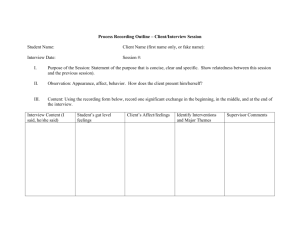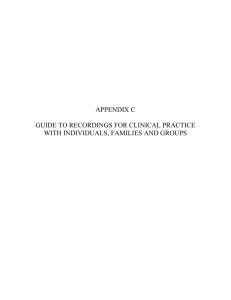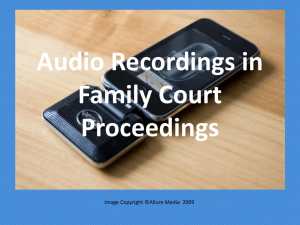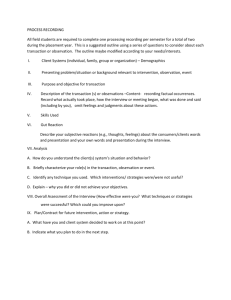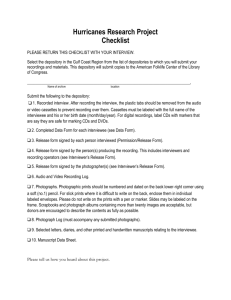PROCESS RECORDING OUTLINE FOR PROCESS RECORDING
advertisement
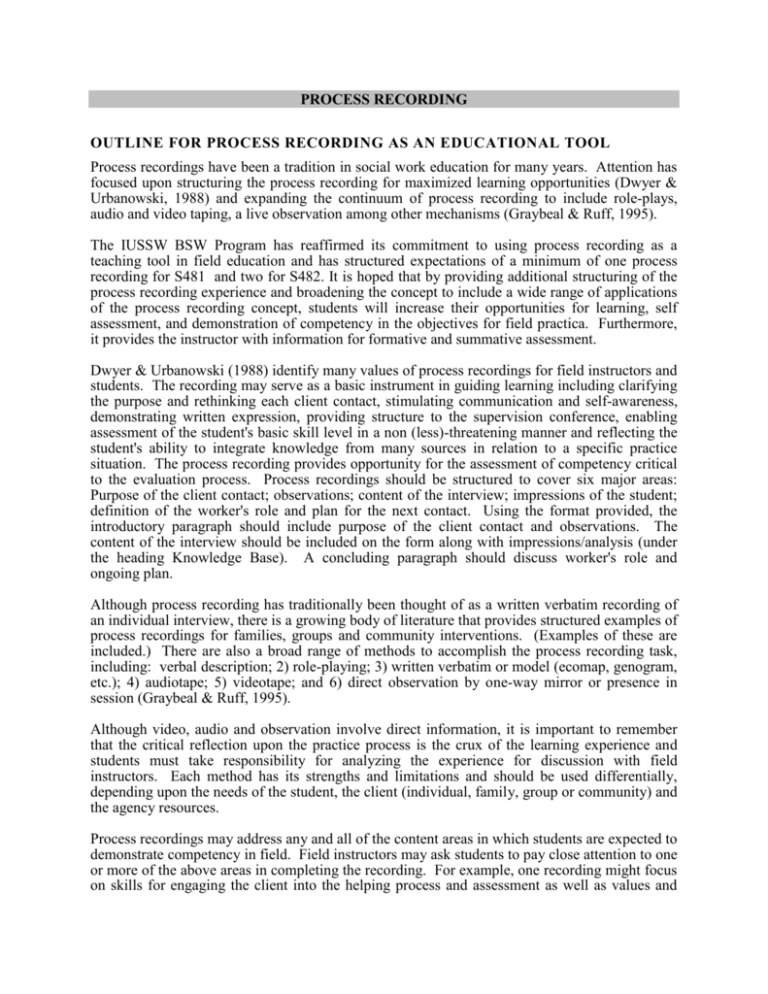
PROCESS RECORDING OUTLINE FOR PROCESS RECORDING AS AN EDUCATIONAL TOOL Process recordings have been a tradition in social work education for many years. Attention has focused upon structuring the process recording for maximized learning opportunities (Dwyer & Urbanowski, 1988) and expanding the continuum of process recording to include role-plays, audio and video taping, a live observation among other mechanisms (Graybeal & Ruff, 1995). The IUSSW BSW Program has reaffirmed its commitment to using process recording as a teaching tool in field education and has structured expectations of a minimum of one process recording for S481 and two for S482. It is hoped that by providing additional structuring of the process recording experience and broadening the concept to include a wide range of applications of the process recording concept, students will increase their opportunities for learning, self assessment, and demonstration of competency in the objectives for field practica. Furthermore, it provides the instructor with information for formative and summative assessment. Dwyer & Urbanowski (1988) identify many values of process recordings for field instructors and students. The recording may serve as a basic instrument in guiding learning including clarifying the purpose and rethinking each client contact, stimulating communication and self-awareness, demonstrating written expression, providing structure to the supervision conference, enabling assessment of the student's basic skill level in a non (less)-threatening manner and reflecting the student's ability to integrate knowledge from many sources in relation to a specific practice situation. The process recording provides opportunity for the assessment of competency critical to the evaluation process. Process recordings should be structured to cover six major areas: Purpose of the client contact; observations; content of the interview; impressions of the student; definition of the worker's role and plan for the next contact. Using the format provided, the introductory paragraph should include purpose of the client contact and observations. The content of the interview should be included on the form along with impressions/analysis (under the heading Knowledge Base). A concluding paragraph should discuss worker's role and ongoing plan. Although process recording has traditionally been thought of as a written verbatim recording of an individual interview, there is a growing body of literature that provides structured examples of process recordings for families, groups and community interventions. (Examples of these are included.) There are also a broad range of methods to accomplish the process recording task, including: verbal description; 2) role-playing; 3) written verbatim or model (ecomap, genogram, etc.); 4) audiotape; 5) videotape; and 6) direct observation by one-way mirror or presence in session (Graybeal & Ruff, 1995). Although video, audio and observation involve direct information, it is important to remember that the critical reflection upon the practice process is the crux of the learning experience and students must take responsibility for analyzing the experience for discussion with field instructors. Each method has its strengths and limitations and should be used differentially, depending upon the needs of the student, the client (individual, family, group or community) and the agency resources. Process recordings may address any and all of the content areas in which students are expected to demonstrate competency in field. Field instructors may ask students to pay close attention to one or more of the above areas in completing the recording. For example, one recording might focus on skills for engaging the client into the helping process and assessment as well as values and skills for working with oppressed populations. Later in the semester, a recording might focus upon the work phase of the interview with special attention on contracting and confrontation skills and the comparison of various theoretical frameworks from which to operate. Toward the end of the semester, it might be appropriate to focus upon termination skills and implications for broader cause advocacy and social policy development. In summary, process recording is a flexible and creative learning tool for both students and field instructors to maximize learning opportunities in agency-based placements. Undoubtedly, it provides additional opportunities for learning the art and skills of social work practice. AUDIO OR VIDEO TAPING IN LIEU OF WRITTEN PROCESS RECORDINGS Over the course of the BSW practicum placements, students are required to complete at least three process recordings—at least one recording of the student’s work with an individual and one of the three recordings of the student’s work with small groups/family and/or community. Self and field instructor critiqued audio and/or video tapings may substitute for written process recordings. Audiotapes and videotapes have several advantages over process recording. They demonstrate how much or little students and clients talk during the interaction, the modulation, tenor and emotion of voices, as well as the pace of the interaction. Students and field instructors can better access the tones, attitudes, and subtleties not available in a written process record. Videotapes also show body language and movement in the room as well as the dialogue with all its inflections. They save the work of remembering the interaction in the session. Students will need to discuss audio and videotaping with their field instructors. Together you can begin the planning for audio or videotaping. You must obtain the client’s permission to tape prior to taping. The Consent for Audio or Video Recording Form is required to be completed before recording any client sessions. This form acknowledges the client’s permission for use of the tape in the student’s supervision and gives permission for the supervisor to hear the tape. It often states when the tape will be destroyed. If the agency does not have such a form, then the student and field instructor will need to create one. Most clients do not mind being taped when they understand how you will use the tape and that you feel it will help you to provide your best service. Remember you must also obtain parental permission to tape a child under age 18. Some guidelines to follow: 1. Test the equipment and make sure you know how to operate it. Have it set up and ready to go for the interaction to minimize the distraction for you and the client. 2. As a way to warm up to the process, you may want to tape 1-2 sessions, listen to them on your own, and provide your own constructive criticism before you give your field instructor a tape. 3. You should always review and critique a tape before giving it to the field instructor. Analyze the material in relation to your feelings and thoughts and the theoretical concepts you were using. Make notes of aspects of the tape that you view as positive and develop a list of questions for discussion with your field instructor about the tape. Develop a list of next steps and tasks as a result of the taped interaction. Your field instructor may not listen to all of the tape. For example, in the beginning of a placement, the field instructor may be especially interested in the first 10-15 minutes of how you began work with clients. Or they may be interested in helping you develop new responses to particular aspects of your work with clients and ask you to play those sections of the tape for joint review. INDIVIDUAL PROCESS RECORDING INSTRUCTIONS *Process recording assists in the development of social work practice skills by allowing reflection on communications used in interviewing clients. The process recording should include the following: 1. Pre-Engagement Comments Prior to meeting with the client, the student writes down the purpose, goal, and intended outcome. Also list any planning and preparation efforts. 2. Transactions The student writes down at least 10 minutes of communications with the client(s). Each statement, question, or response is recorded along with any emotional (laughter, crying, yelling) display. Use “SW” for student and “C” for client, “C2” another client etc. Record as accurately as possible. 3. Feelings/Gut Reactions The student records their emotional-gut level responses to what has transpired. 4. Using the Knowledge Base The student will apply social work practice knowledge, values, and theory to their communication with clients. See the example below. The following are some examples of the social work “knowledge base” : Theories: Systems, Ecological, Feminist, Behavioral, Psychodynamic, Life Span Theory, Cognitive Development Models, , etc. Frameworks/Approaches: Empowerment, Risk and Resiliency, Strengths, Generalist Practice Roles, Case Management, Cultural Competence, Crisis Intervention, Group Practice, etc. Practice Skills: Introduction and development of rapport, Reflecting content, Reflecting feeling, Conducting assessments & social history, Seeking clarification, Goal setting, Reaching consensus or agreement, etc. EXAMPLES: 2. Transactions (Record the flow of client/social worker communications) Client: “My sister went off with friends and left me standing there. I can’t believe she would do that to me.” (crying) 4. Using the Knowledge Base Reflecting feeling SW: “Sounds like you’re pretty upset with your sister.” Building rapport Clients: “I don’t know how I can get a job, pay these bills, and care for children.” SW: “Would you describe a previous time when you got through a rough situation?” Client: “I need to move out from my boyfriend’s home and need to check on my parents who live in Florida.” SW: “Which of these concerns do you think you want to talk about first?” Client: “I just was diagnosed with cancer, but don’t know how serious it is yet.” SW: “Who do you go to for support?” Client: “My son was expelled from school a month ago and I can’t eat or concentrate and don’t know what to do.” SW: “Has your sleep been affected by worrying about this issue?” Crisis Intervention Theory; Strengths perspective Goal setting; Empowerment perspective Strengths perspective; Assessment of assets Bio-psycho-social; Systems Theory 5. Field Instructor Comments The field instructor should make comments, notes, or raise questions in relation to the interview. 6. Plans The student thinks ahead and projects the next steps in the intervention. 7. Questions The student takes initiative for her/his own learning and identifies areas where knowledge, skills and/or help are needed. INDIVIDUAL PROCESS RECORDING Name of Student: _________________________Date of Interview: ___________________ Persons Present for Interview: __________________________________________________ 1. Pre-Engagement Comments: 2. Transactions 3. Feelings/Gut Feelings 4. Using the Knowledge Base 5. Field Instructor Comments 2. Transactions 3. Feelings/Gut Feelings 4. Using the Knowledge Base 5. Field Instructor Comments INDIVIDUAL PROCESS RECORDING 6. Plans 1. 2. 3. 4. 5. 7. Questions 1. 2. 3. 4. 5. OUTLINE FOR GROUP PROSPECTUS This is a planning document for group practice. Every BSW student should have the experience of completing this outline in S481 and/or S482. 1. Relationship to Agency How does your group relate to the overall mission and purpose of the agency? What kind of staff and administrative support exists for this group? Is this an ongoing service of the agency? 2. Client Population Identify the specific population for whom the group serves. What are their common needs? How did you become aware of these commonalities you have identified? What factors influenced your choice of a small group approach? 3. Goals and Objectives What are the goals/objectives for your group? 4. Theoretical Background What theoretical knowledge/concepts will be needed to work with the group? 5. Main Themes What are the expected themes/issues to be pursued in the group? 6. Proposed Activities What are the proposed programs and/or activities? 7. Membership What are the criteria for membership in your group? How will group members be selected and/or recruited? How will they be informed or screened for the group? 8. Role of Worker What will be your initial and ongoing role in this group? How will you work together with a co-leader to maximize effectiveness? 9. Diversity Issues Are there any racial, ethnic or sexual diversity issues related to the client population, worker(s) or agency orientation? How will these issues relate to group functioning? 10. Size of Group What is the preferred and actual size of the group? What is your rationale for the size of the group? 11. Physical Structures Where will meetings be held? What factors were considered in selecting this location? What will be the length and frequency of the meetings? How long will group last? 12. Recording What types of forms are needed? What type of record keeping is required? Who needs to be kept informed of client progress? 13. Evaluation What is the plan for evaluating the service given? Who will be involved? By what criteria and method will service be evaluated? Indiana University School of Social Work PROCESS RECORDING OUTLINE FOR GROUP PRACTICE Group Process Recording Outline A. Information about the Group Group Name: Group Type: Date of Group: Group Members Present: B. Purpose of the Group/Meeting 1. Write a brief statement on the overall purpose of the group a. This statement is include only in the first process recording, or it there is an agreed upon change in the group's overall purpose. 2. Write a concise statement about the goals of the meeting of the group being recorded. a. How were these goals perceived by the group? b. How did you perceive these goals? c. What are the similarities or differences between the group's perception of these goals and yours? C. Group Process at the Meeting 1. Initial Observations a. Describe briefly, in general terms, the physical and emotional climate at the beginning of the group meeting. b. Describe briefly your initial impressions of the attitudes and feelings of the group members at the beginning of the meeting. c. Describe any significant changes in the appearance or feelings or attitudes of the group members since the last meeting. 2. Group Member Interaction (Group Process) a. Describe what went on within the group during its meeting. For example: (1) Describe the means of interaction, e.g., program activity, discussion, debate, tasks, etc. (2) Describe the feeling reactions of the members to this interaction. (3) Describe your feeling reactions to this interaction. b. Describe the effectiveness, vitality, and responsibility of the group's members during the interaction. c. Describe your role in the group's interaction. d. Describe the ways the group moved toward attainment of its goals. e. Describe how the group's members dealt with obstacles to attainment of the meeting's goals. D. Analysis of the Group Meeting 1. Describe your understanding of the nature of the interaction of the group members, including you, at this group meeting. 2. Indicate the theoretical or other knowledge, learned in your other courses, that helps you to understand the process and content of this group meeting. 3. On the basis of your analysis, what is your current assessment of: a. the stage of the group's development, b. the commitment of the group members to the group's purpose, c. the climate and tone of the group, d. if relevant, discuss specific roles played by individual group members and how they impact the group process. E. Plan for the Group's Next Meeting 1. Write a brief statement of the plan for the next meeting of the group. a. Explain how the members of the group, including you, arrived at this plan. b. Explain how the plan relates to the purpose of the group. 2. Describe what you and the other group members are to do prior to, and in preparation for, the next group meeting. F. Analysis of the Student Social Worker's Practice 1. Discuss your use of social work practice knowledge and skills during the group meeting. a. What specific social work skills and/or techniques learned in your practice courses, did you use during the group meeting? b. What were the strengths and weaknesses in your practice during the group meeting? A. Community/Organizational Process Recording Outline Identifying Information 1. Name of the community group (committee, task force, board, etc.) 2. Overall purpose of the community group (committee, task force, board, etc.) 3. Date of the meeting or activity being process recorded. 4. Representatives present at and absent from the meeting or activity. 5. Name of the person who called the meeting or activity. a. Indicate this person’s position. b. Indicate the method of notification for the meeting or activity. c. Indicate how much time was allowed between notification and the date of the meeting or activity. d. Indicate if it was a regular meeting or a special meeting. B. Pre-meeting or Pre-activity Goals and Perceptions 1. Describe briefly the goals stated for the meeting or activity. a. Attach the agenda, if there is one. b. Include a discussion of the task and process goals specified for the meeting or activity in your description. 2. Describe briefly your own goal expectations for this meeting or activity, including a brief statement of your own task and process goals. C. Meeting or Activity Process 1. Describe the role played by the chair or group leader. a. Indicate how the chair or leader played this role. b. Indicate the impact/influence of the chair or leader on the actions of the others present, including you. c. Indicate the leadership style used by the chair or leader taking into consideration communication style and skill, decision making, and problem solving strategies. 2. Summarize the overall interaction of those present at the meeting or activity. a. Indicate the interactional roles played by different group members. b. Describe any cliques, leadership patterns, or other factors that develop during the interaction. c. Describe the atmosphere of the meeting or activity. 3. Describe any decisions made or actions taken during the meeting or activity, including how they were introduced and how the decisions were made. 4. Describe the plans for the next meeting or activity of this group, i.e., future agenda items, including a brief description of how the group reached consensus. D. Analysis of the Meeting or Activity 1. Analyze the actions, decisions, conclusions or other interactions that occurred in the group and indicate why you think they occurred. a. Assess the roles that members played that were significant to the interaction of the group. b. Assess the cliques, leadership patterns, or other significant variables that influenced the interaction. c. Assess the personal motivations of members in regard to the roles, cliques, patterns and other behaviors that emerged in the meeting or during the activity and elaborate about how these personal motivations might impact the interaction. 2. On the basis of your analysis, what is your current assessment of: a. The commitment of the people involved in this group, committee, task force, board, etc., to the defined purpose. b. The motivation of the community or agency people involved to achieve this purpose. c. Evaluate the growth of leadership in this meeting or activity, including the group’s capacity to solve the challenges or tasks facing it. 3. Describe the group’s organizational culture and its impact on the purpose, format, norms, and process of the meeting or activity. 4. Describe any unarticulated agendas, goals, or issues that influenced the group member’s interaction. 5. Describe and discuss differences in the power, status, roles, and diversity and the impact these differences had on the meeting or activity. 6. Describe how the meeting or activity was evaluated and by whom. Describe the nature of the evaluation: Formal, informal, summative, formative. 7. Discuss the use of human, organizational, and/or community resources, i.e., time, materials, expertise, information management, etc. Analysis of Student’s Practice E. 1. Define your goals for the meeting or activity and explain how they were or were not attained. 2. Identify and analyze your feelings during the meeting or activity about: a. Specific members/participants b. The content of the meeting activity, i.e., apprehension, elation, anger, fear, frustration, etc. c. The way your feelings influenced the actions and course of the meeting or activity including your own action or non-action. 3. Describe specific theoretical content and skills and/or techniques learned in social work courses that you used during the meeting or activity. 4. Describe specific theoretical content skills and/or techniques learned in your practice courses you could have used during the meeting or activity. 5. Discuss strengths and deficits in your practice during the meeting or activity. 6. Identify next steps (if any). 7. Identify areas where knowledge, skills, and/or help are needed to carry future similar assignment? Adapted from Virginia Commonwealth University as printed in the IU School of Social Work MSW Student Handbook & Field Manual. Additions suggested by Dr. Theresa Roberts and Dr. Irene Queiro-Tajalli, Indiana University School of Social Work. References Dwyer, M., & Urbanowski, M. (1988). Learning through field instruction: A guide for teachers and students. Milwaukee, WI: Family Service America. Graybeal, C.T., & Ruff, E. (1995). Process recording: It’s more than you think. Journal of Social Work Education, 31(2), 169-181.


